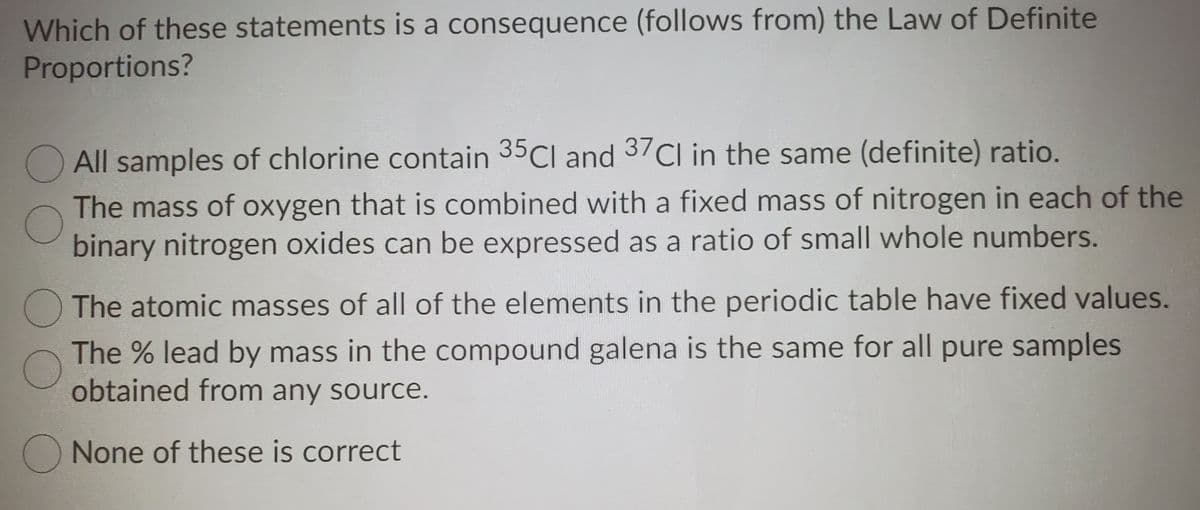Which of these statements is a consequence (follows from) the Law of Definite Proportions? O All samples of chlorine contain 35CI and 37CI in the same (definite) ratio. The mass of oxygen that is combined with a fixed mass of nitrogen in each of the binary nitrogen oxides can be expressed as a ratio of small whole numbers. O The atomic masses of all of the elements in the periodic table have fixed values. The % lead by mass in the compound galena is the same for all pure samples obtained from any source. O None of these is correct
Which of these statements is a consequence (follows from) the Law of Definite Proportions? O All samples of chlorine contain 35CI and 37CI in the same (definite) ratio. The mass of oxygen that is combined with a fixed mass of nitrogen in each of the binary nitrogen oxides can be expressed as a ratio of small whole numbers. O The atomic masses of all of the elements in the periodic table have fixed values. The % lead by mass in the compound galena is the same for all pure samples obtained from any source. O None of these is correct
Chemistry: Principles and Reactions
8th Edition
ISBN:9781305079373
Author:William L. Masterton, Cecile N. Hurley
Publisher:William L. Masterton, Cecile N. Hurley
Chapter2: Atoms, Molecules, And Ions
Section: Chapter Questions
Problem 3QAP: Two basic laws of chemistry are the law of conservation of mass and the law of constant composition....
Related questions
Question

Transcribed Image Text:Which of these statements is a consequence (follows from) the Law of Definite
Proportions?
O All samples of chlorine contain 35CI and 37Cl in the same (definite) ratio.
The mass of oxygen that is combined with a fixed mass of nitrogen in each of the
binary nitrogen oxides can be expressed as a ratio of small whole numbers.
The atomic masses of all of the elements in the periodic table have fixed values.
The % lead by mass in the compound galena is the same for all pure samples
obtained from any source.
None of these is correct
Expert Solution
This question has been solved!
Explore an expertly crafted, step-by-step solution for a thorough understanding of key concepts.
This is a popular solution!
Trending now
This is a popular solution!
Step by step
Solved in 2 steps with 2 images

Recommended textbooks for you

Chemistry: Principles and Reactions
Chemistry
ISBN:
9781305079373
Author:
William L. Masterton, Cecile N. Hurley
Publisher:
Cengage Learning

Chemistry: The Molecular Science
Chemistry
ISBN:
9781285199047
Author:
John W. Moore, Conrad L. Stanitski
Publisher:
Cengage Learning

Chemistry
Chemistry
ISBN:
9781305957404
Author:
Steven S. Zumdahl, Susan A. Zumdahl, Donald J. DeCoste
Publisher:
Cengage Learning

Chemistry: Principles and Reactions
Chemistry
ISBN:
9781305079373
Author:
William L. Masterton, Cecile N. Hurley
Publisher:
Cengage Learning

Chemistry: The Molecular Science
Chemistry
ISBN:
9781285199047
Author:
John W. Moore, Conrad L. Stanitski
Publisher:
Cengage Learning

Chemistry
Chemistry
ISBN:
9781305957404
Author:
Steven S. Zumdahl, Susan A. Zumdahl, Donald J. DeCoste
Publisher:
Cengage Learning

Chemistry: An Atoms First Approach
Chemistry
ISBN:
9781305079243
Author:
Steven S. Zumdahl, Susan A. Zumdahl
Publisher:
Cengage Learning


Chemistry & Chemical Reactivity
Chemistry
ISBN:
9781337399074
Author:
John C. Kotz, Paul M. Treichel, John Townsend, David Treichel
Publisher:
Cengage Learning